Iran’s military support for Russia’s 2022 invasion of Ukraine has soured diplomatic relations between Tehran and Kyiv. In September, Ukraine downgraded formal ties with Iran for providing armed drones to Russia. By the end of 2022, Russia had used hundreds of drones on Ukrainian military positions as well as civilian infrastructure. But Ukraine had yet to sever ties as of mid-2023.
In December 1991, Iran recognized Ukraine’s independence from the Soviet Union. Relations were largely amicable for the next three decades but never reached their full potential. Initially, the two seemed like natural partners. Ukraine was eager to reduce its dependence on Russian energy. And Iran was looking for new markets for oil and natural gas. In the 1990s, eight Iranian ministers visited Ukraine, and seven senior Ukrainian officials – including President Leonid Kravchuck (1991-1994) – visited Iran. “We regard Iran as a country that will help open our passage to the Middle East,” Kravchuck said after his 1992 trip to Tehran.
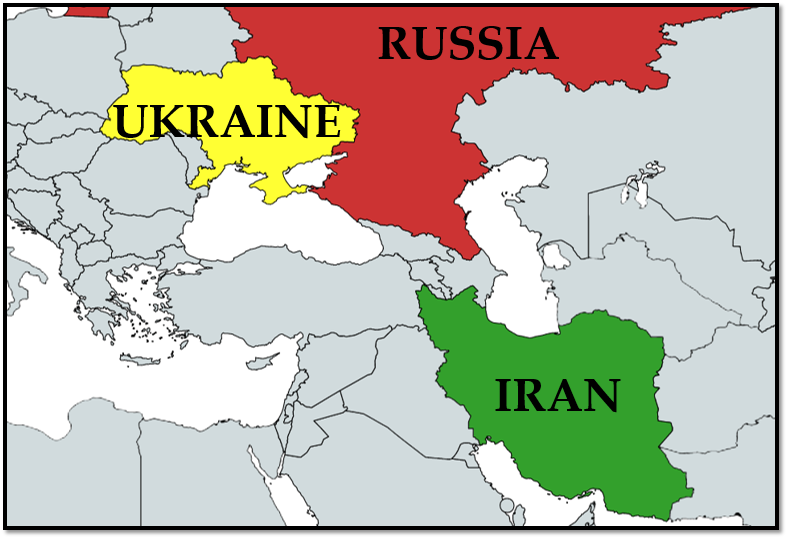
Energy, Trade & Arms
Officials signed ambitious agreements to build pipelines and exchange goods for oil and gas. But most deals never came to fruition. Iran blamed Ukraine, which had a difficult time weaning itself off Russia. Ukraine had “failed to make its contribution” to joint oil and gas ventures, Oil Minister Gholam Reza Aghazadeh said during a 1993 visit to Kyiv.
As of 2021, the year before the war, Iran’s top exports to Ukraine included styrene polymers (plastic often used in packaging) and medicine, as well as fruits and nuts. Its top imports from Ukraine were mostly raw foodstuffs: corn, seed oils, wheat, and barley. Iran suffered grain shortages that year due to a drought. The Islamic Republic, a net importer of food, has historically purchased Ukrainian grains and oils.
In 2022, the two countries largely traded the same types of goods, but overall trade plunged amid Russia’s invasion. Iranian imports from Ukraine dropped by some two-thirds. And Iranian exports fell 38 percent.
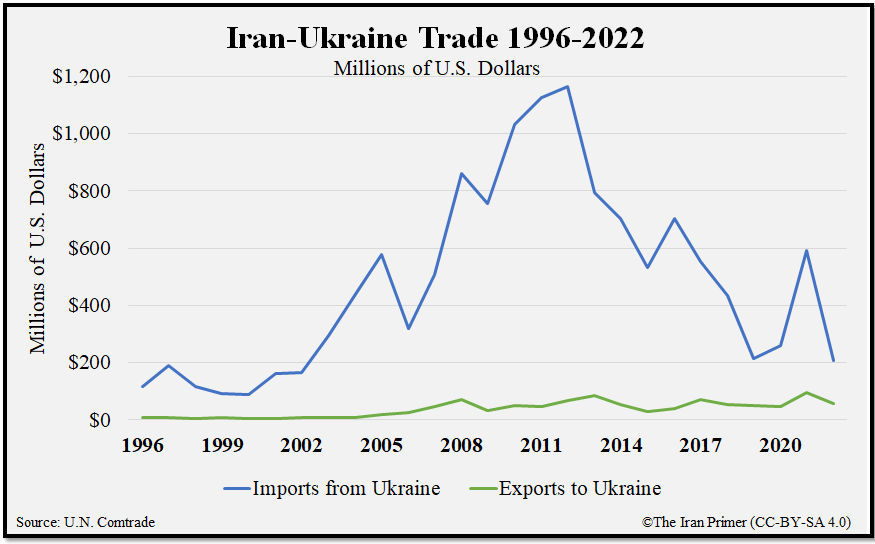
Ukraine has exported a limited number of arms to Iran. Ukraine sold eight Sunburn anti-ship missiles to Iran in 1992. “Through its active efforts to acquire offensive weapons, Iran is seeking an ability to dominate the gulf by military means,” Martin Indyk of the National Security Council warned in a 1993 speech. In 2001, Ukraine secretly sold 12 cruise missiles to Iran and six to China. The X-55 missiles, with a range of 3,000 kilometers (1,864 miles), were capable of striking Israel from Iran. They could also carry conventional or nuclear warheads.
Tensions: Downed Airliner & Russian Invasion
Tensions escalated in January 2020 after the Revolutionary Guards shot down a commercial airliner, Ukrainian Airlines flight PS752, over Iranian airspace. All 176 onboard – including 11 Ukrainians and 82 Iranians – were killed. After three days of denying responsibility, Iran acknowledged it had mistakenly shot down the plane. The incident occurred early on January 8, hours after Iran launched missiles at two Iraqi military bases housing U.S. troops in retaliation for the U.S. killing of Qassem Soleimani, the head of the elite Qods Force. So Iranian forces were on alert.
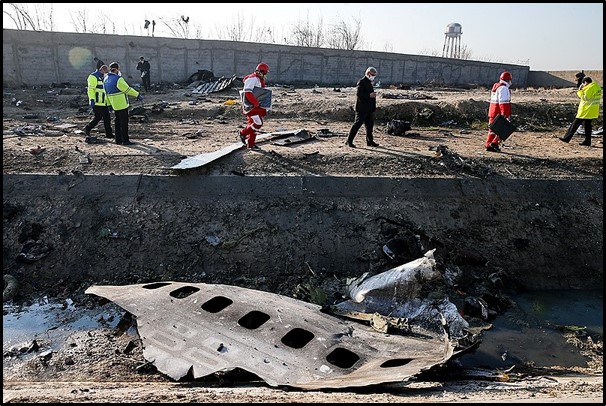
Ukrainian President Zelensky (2019-) initiated a probe into the crash. “We expect from Iran assurances of their readiness for a full and open investigation, bringing those responsible to justice, the return of the bodies of the dead, the payment of compensation, official apologies through diplomatic channels,” he said.
Bilateral relations plummeted further after Russia invaded Ukraine in February 2022. Iran was initially hesitant to take sides. But in July 2022, Supreme Leader Ayatollah Ali Khamenei explicitly backed Moscow’s position during a visit to Tehran by Russian President Vladimir Putin. “If you had not taken the helm, the other side would have done so and initiated a war,” he told Putin. Tehran’s decision to support Moscow reflected their expanding strategic alliance at the expense of Iran-Ukraine relations.
Related Material: Iran Blames U.S., West for Ukraine War
Iran claimed neutrality while covertly providing Russia with armed drones. In September 2022, Ukraine stripped Iran’s ambassador of his accreditation and reduced the size of Iran’s diplomatic staff in Kyiv. “Supplying Russia with weapons to wage war against Ukraine is an unfriendly act that deals a serious blow to relations,” said Ukraine’s Foreign Ministry.
Related Material: Timeline: Iran-Russia Collaboration on Drones
By the end of 2022, Iran had reportedly supplied Russia some 1,700 unmanned aerial vehicles, including Shahed series suicide drones and Mohajer-6 reconnaissance and strike drones, according to Ukrainian military intelligence. Iran had shipped artillery and tank rounds as well. Russia used the drones on Ukrainian military positions as well as residential buildings, power stations, bridges, playgrounds, sewage treatment plants and other infrastructure, killing civilians.
For months, Iran denied sending weapons to Russia. In November 2022, however, Foreign Minister Amir-Abdollahian admitted that Tehran had transferred drones. “We gave a limited number of drones to Russia months before the Ukraine war,” he told reporters.
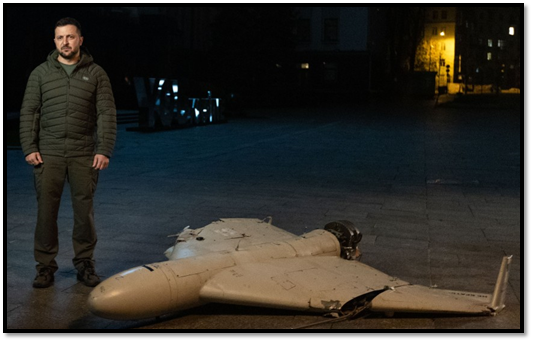
In December 2022, President Zelensky condemned Tehran for backing Moscow. “Russia found an ally in this genocidal policy,” he told the U.S. Congress. “Iranian deadly drones… became a threat to our critical infrastructure. That is how one terrorist has found the other.”
Related Material: Iran’s Deepening Strategic Alliance with Russia
By the end of 2022, Iran had become Russia’s top military backer, according to John Kirby of the National Security Council. “In exchange, Russia is offering Iran an unprecedented level of military and technical support,” Kirby briefed reporters. The following is a timeline of Iran-Ukraine relations.
Timeline
Dec. 25, 1991: Iran recognized Ukraine’s independence from the Soviet Union.
Jan. 22, 1992: Iranian Foreign Minister Ali Akbar Velayati visited Kyiv to meet top Ukrainian officials and establish diplomatic relations. Officials signed a memorandum of understanding on economic cooperation.
Jan. 28-29, 1992: Oil Minister Gholam Reza Aghazadeh arrived in Kyiv to sign a deal to provide Ukraine four million tons of oil and three billion cubic meters of natural gas per year. In exchange, Iran would receive refined petroleum products, building materials, chemicals, and machinery.
Iran, Ukraine and Azerbaijan also announced an agreement to construct three gas pipelines worth $7 billion that could deliver up to 75 billion cubic meters of natural gas per year. It was reportedly Ukraine’s largest economic deal ever. Iranian and Ukrainian officials also announced plans to build an oil pipeline.
Mid-1992: Ukraine reportedly sold eight SS-N-22 “Sunburn” anti-ship missiles to Iran for around $600,000 each. Both the United States and Russia were concerned about Ukraine’s sales of Soviet arms.

April 26, 1992: Ukrainian President Leonid Kravchuk (1991-1994) visited Iran at the invitation of President Akbar Hashemi Rafsanjani (1989-1997). They signed a declaration of friendship and agreements to cooperate on science and technology, geological research, and diplomatic relations. “We regard Iran as a country that will help open our passage to the Middle East,” Kravchuk said.
1993: Ukraine sold 10 S-200 units to Iran. The S-200 is a Soviet strategic surface-to-air system first developed in the 1960s.
May 1993: Two Ukrainian government delegations visited Tehran during consecutive weeks. The first was led by Deputy Prime Minister Yuliy Yoffe, and the second was led by Chairman Ivan Pliushch.
April 8-9, 1995: Ukraine signed an economic and trade agreement with Iran and Turkmenistan during Ukrainian Foreign Minister Gennadiy Udovenko's visit to Tehran. Officials also discussed a potential deal in which Ukraine would export raw minerals to Iran for assistance in constructing a gas pipeline connecting the three countries. Udovenko invited Iranian President Rafsanjani to Ukraine.
Sept. 9, 1995: The Iranian, Ukrainian, and Turkmen foreign ministers met in Ashgabat, Turkmenistan to build on the April 1995 talks. They discussed Ukrainian payment options for Turkmen gas. Turkmenistan and Iran sought industrial technology from Ukraine. The three ministers also discussed economic initiatives including development of oil fields in the Caspian Sea and pipeline construction.
March 4-5, 1996: Iranian Foreign Minister Velayati visited Kyiv to expand economic relations. Velayati met with Ukrainian Prime Minister Yevhen Marchuk and Foreign Minister Hennadiy Udovenko. Iran asked Ukraine to be a member of a free economic zone along the Iran-Turkmenistan border. They also discussed a trilateral gas plan between Ukraine, Iran, and Turkmenistan.
March 12, 1996: The Ukrainian Cabinet of Ministers reportedly approved a plan to build Ukrainian aircraft in Iran.
November 1996: Ukrainian President Leonid Kuchma (1994-2005) assured Israeli Prime Minister Benjamin Netanyahu that Ukraine would not sign arms deals with Iran.
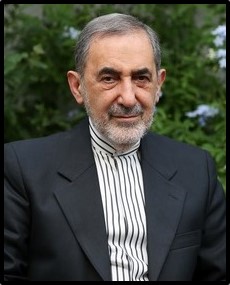
June 9, 1997: Iranian Foreign Minister Velayati and Ukrainian Foreign Minister Udovenko signed an economic cooperation agreement and vowed to develop ties. Velayati emphasized his desire to strengthen relations between the two countries, particularly “in the sphere of oil, energy and gas,” during a three-day trip to Ukraine. Iran sought to assist Ukraine in the construction of the Odessa Oil Terminal to connect it to a European oil pipeline. Velayati visited an airplane factory that produced a passenger plane that would be manufactured in Iran under license. Udovenko said that the $100 million in annual trade between the two countries would increase quickly.
2001: Ukraine, under the Kuchma administration, secretly sold 12 cruise missiles to Iran and six to China. The Kh-55 (also known as X-55) missiles, with a range of 3,000 kilometers (1,864 miles), were capable of striking Israel from Iran. They had the capability to carry conventional or nuclear warheads. The sale was a violation of the Missile Technology Control Regime (MTCR), which Ukraine had joined in 1998. In 2005, Ukrainian President Viktor Yushchenko (2005-2010) admitted to the sale and promised to investigate the incident.
Feb. 6-7, 2001: Ukrainian Prime Minister Viktor Yushchenko visited Iran.
Feb. 19, 2002: Ukraine would maintain ties with Iran despite U.S. President George Bush’s description of Iran as part of the “Axis of Evil,” said Ukrainian Foreign Ministry Spokesperson Ihor Dolhov. “No country should dictate its policy to others and act unilaterally,” he said.
May 13, 2002: The Ukrainian Defense Ministry denied reports that it had cooperated with Iran to sell weapons to Bosnian Muslims in 1994. German and Dutch security services had accused Kyiv of allowing Iranian planes to take on arms in Ukraine for transport to fighters during the Bosnian War.
Oct. 15-16, 2002: Iranian President Mohammed Khatami (1997-2005) made an official visit to Ukraine. Khatami and Ukrainian President Kuchma agreed on joint airplane construction plans and discussed a potential gas pipeline between Iran, Ukraine, and Europe. The two countries finalized agreements on trade, healthcare, and anti-drug trafficking. The presidents also supported a peaceful resolution to U.S.-Iraq tensions.
July 11-13, 2005: Ukraine’s Secretary of National Security and Defense visited Iran.
September 2007: Ukraine, in support of a 2006 U.N. Security Council resolution, sanctioned Iran and banned exports that could be utilized for nuclear purposes.
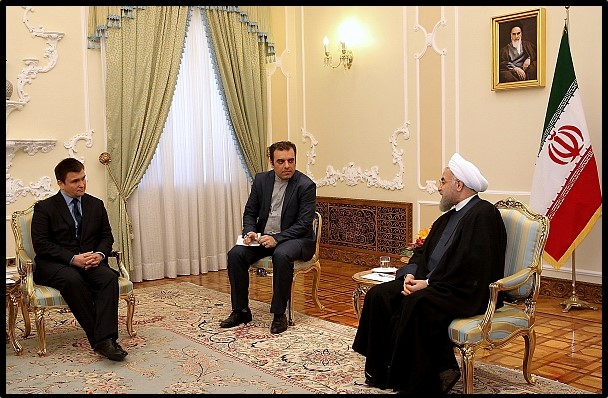
May 29, 2016: Ukrainian Foreign Minister Klimkin visited Iran and met with President Rouhani (2013-2021). “In the road map of deepening Kiev-Tehran ties, we seek to have close relations with Iran in all fields, such as economic, agricultural and energy areas,” he told Rouhani. Klimkin also met with Iranian Foreign Minister Zarif, and interim Parliamentary Speaker Ali Larijani.
Oct. 26-27, 2016: An Iranian Foreign Ministry delegation visited Ukraine for consultations on energy, trade, agriculture, and joint projects. The two countries agreed to “intensify political dialogue at different levels,” a Ukrainian Foreign Ministry statement said.
Feb. 18, 2017: Ukrainian Foreign Minister Pavlo Klimkin met with Iranian Foreign Minister Mohammad Javad Zarif during the Munich Security Conference. The ministers discussed a “road map” for bilateral relations and developing economic ties. They also discussed the conflict in Syria.
Jan. 8, 2020: After three days of denying responsibility, Iran acknowledged on January 11 that it had shot down Ukraine International Airlines Flight 752. The incident occurred early on January 8, hours after Iran launched missiles at two Iraqi military bases housing U.S. troops in retaliation for the U.S. killing of Qassem Soleimani, the head of the elite Qods Force. Iran admitted fault after Western intelligence officials said the evidence suggested the plane was hit by a missile. The Islamic Revolutionary Guard Corps (IRGC) claimed responsibility.
All 176 people on board were killed, including 82 Iranians, 63 Canadians, 11 Ukrainians, 10 Swedes, four Afghans, three Germans and three British nationals, according to Ukrainian Foreign Minister Vadym Prystaiko. Ukrainian President Volodymyr Zelenskyy initiated a criminal investigation after the crash. In 2022, National Defense and Security Council Secretary Oleksiy Danilov accused Iran of committing a terrorist act.
Jul. 11, 2022: White House National Security Advisor Jake Sullivan revealed that Iran was preparing to provide Russia with “up to several hundred” drones for use in the war on Ukraine.
Jul. 15, 2022: In a call with Ukrainian Foreign Minister Dmytro Kuleba, Iranian Foreign Minister Hossein Amir-Abdollahian expressed condolences for those killed in a Russian strike on the city of Vinnitsya. He assured Kuleba that Iran would not buy grain stolen from Ukraine.
Aug. 19, 2022: Russian cargo planes carrying at least three types of Iranian reconnaissance and attack drones reportedly departed Tehran. By the end of the month, Russia was firing Shahed-136 suicide drones at Ukrainian troops.
Today, I received a call from Iranian Foreign Minister Hossein Amir Abdollahian, during which I demanded Iran to immediately cease the flow of weapons to Russia used to kill civilians and destroy critical infrastructure in Ukraine.
— Dmytro Kuleba (@DmytroKuleba) October 28, 2022
Sept. 23, 2022: Ukraine stripped Iranian Ambassador to Ukraine Manouchehr Moradi of his accreditation over Iran’s support for Russia’s invasion of Ukraine. “Supplying Russia with weapons to wage war against Ukraine is an unfriendly act that deals a serious blow to relations between Ukraine and Iran,” the Ukrainian Foreign Ministry said. President Zelensky also announced that Iranian diplomatic staff in Ukraine would be reduced. “Today the Russian army used Iranian drones for its attacks on the Dnipropetrovsk region and Odesa,” Zelensky said. “I instructed the Ministry of Foreign Affairs to strongly react to this fact.”
Oct. 15, 2022: Iran’s foreign ministry denied supplying Russia with drones. “The Islamic Republic of Iran has not and will not provide any weapon to be used in the war in Ukraine,” said Iranian Foreign Minister Hossein Amir-Abdollahian.
Oct. 17, 2022: Ukraine demanded that Iran cease providing Russia with weapons for its invasion of Ukraine. “Iran and its leadership will bear the strictest responsibility, including within the framework of international legal proceedings addressing Russia's crimes against Ukraine,” the foreign ministry said. Foreign Minister Kuleba also called on the European Union to sanction Iran.
Oct. 18, 2022: Foreign Minister Kuleba suggested that Ukraine should cut diplomatic ties with Iran. “Given the amount of destruction Iranian drones have caused to Ukrainian civilian infrastructure, the deaths and injuries caused to our people, as well as… the possible continuation of Iran’s supply of weapons to Russia, I submitted a proposal to break off diplomatic ties with Iran to the Ukrainian president,” Kuleba said in a Facebook video.
Nov. 5, 2022: Foreign Minister Amir-Abdollahian admitted that Iran had supplied drones to Russia. But he claimed that they had been delivered to Russia months before the war began.
November 2022: Iran and Ukraine held talks in Oman over Iran’s supply of weapons to Russia, Amwaj reported. The talks were reportedly held at the “expert and technical level” and included civilian and military officials. Ukraine shared evidence of the Iranian drones being used by Russia. Iran claimed that the “gear was sold much earlier [than the war]” and that they could be copies of Iranian drones.
March 21, 2023: Ukraine imposed unilateral sanctions on 300 individuals and 141 entities connected to Russia’s invasion. Most were Russian, but Ukraine also sanctioned a number of Iranian citizens and businesses linked to Tehran’s supply of drones to Moscow. The sanctions targeted the IRGC Aerospace Force chiefs and Iranian companies involved in the production of Shahed suicide drones, which Russia fired on Ukrainian targets.
April 16, 2023: An Iranian court sentenced 10 military personnel for their involvement in the downing of Ukrainian Airlines flight PS752 in 2020. The personnel included the commander of the weapon system that downed the airliner. The commander received 10 years in prison for deploying the weapon without permission and three years for accessory to manslaughter. The nine others were sentenced to one to three years in prison.
Families of victims were not satisfied with the ruling. “This court did not prosecute the commanders and main perpetrators of this crime, introduced 10 accused low-ranking officers with total obscurity of their backgrounds and identities, held sessions in private, flouted the families who attended the hearings, and ultimately issued a sham ruling…,” the Association of Families of Flight PS752 Victims said.
Aaron Boehm, a research analyst at the U.S. Institute of Peace, contributed to this report.
